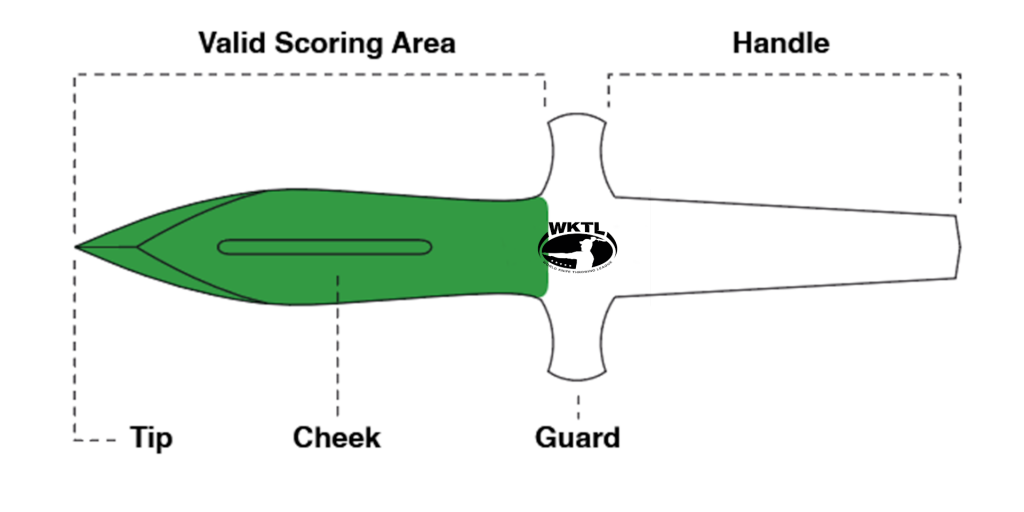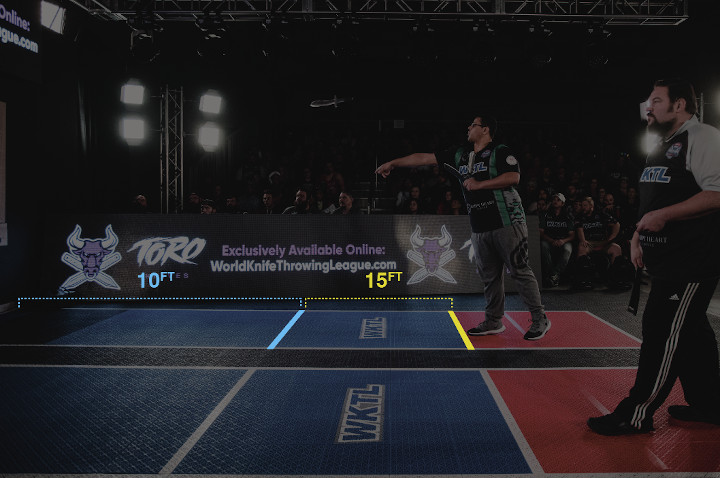Knife Throwing might sound like a dangerous activity, but with the right equipment and setting it can be a fun, engaging and even relaxing activity. When first learning how to throw a knife, the goal is to get a consistent, controlled, and repeatable throw.
In this article we will teach you how to throw a knife by four main principles:
Whether you are new to knife throwing and starting with the basics, or a top level competitor who wants to hone your skill, learning the intricacies of knife throwing will be of great benefit to you. There are several factors that play a key role in how to throw your knife and build a consistent foundation. When combined, each of these individual factors will combine to help you send your blade into the target every time.
What is the best throwing knife? There’s no easy answer, because the best throwing knife is the knife that works best for you! We can help you pick YOUR best throwing knife while looking at your skill level, the purpose for which you plan to use it, and your budget.
What should you look for in your throwing knife? You should consider the size, design, handle, and the weight and balance of the knife. These 4 aspects of a throwing knife are all personal preference, but let’s look at why they are important.
The ideal size will depend on how you wish to use it. Recreational throwers may prefer a shorter knife, while competitors in the World Knife Throwing League must adhere to the league’s specifications for all competition use knives.
The design of the knife is important to consider, whether you prefer a curve to the blade, a straight tip, or maybe a longer handle. Understanding the anatomy of a knife will help you determine what design you like best. Throwing knives have 4 design components: tip, cheek, guard, and handle.

The handle of a knife can be thick and short, long and thin, or any combination of those. Finding a handle that fits your hand best that also provides balance to the knife is important.
Speaking of balance, the last of the 4 important elements of a good throwing knife are weight and balance. The weight distribution of the knife will alter your rotation from different distances, so keep that in mind when making your choice.
For a more in depth review of how to choose the best throwing knife, and a breakdown of some of the BEST knives available, check out our page: What is the best throwing knife for me?
Throwing distance is the first factor to consider before you throw. Distance is one of the things that will heavily affect your rotation so it’s important to understand where you’ll be throwing from the most often. If you will be throwing closer to the target (around 10ft), you’ll want to throw 1 rotation. If you will be throwing from further away (15ft or more), you will need to adjust your grip and throwing technique to compensate for the added rotations needed.
Another thing to consider with distance is the rotation of your knife. If you stand too close to the target, you may under rotate, meaning the knife has not made a full rotation around its center of gravity (or axis). Stepping back a few inches would allow the knife to fully rotate and stick in the target. Vice versa, if you are too far away from the target and over rotating, moving forward a few inches will close the gap.
When throwing in official World Knife Throwing League (WKTL) events, you will throw from both the 10ft (1 rotation) and 15ft (2 rotation) distances. When practicing, find YOUR distance at each of these fault lines. For example, for the 1 rotation throw, you may find that your throwing style is better from 10ft 6in, or the 2 rotation throw works better for you from 18ft. Finding the distance that works best for you is imperative to consistency.

It is important to note that the two distances just demarcate fault lines; many throwers prefer to throw further away from the 10 and 15 ft lines, because more or less distance can result in your preferable rotation.
The way that you grip your knife is important in determining the release and rotation it will take to the target. You want to choose a grip that allows you to control the aim and flight of the knife, and which also feels comfortable for you to hold. You may find a certain grip is great for your aim, but hurts your hand over an extended period of time. Below you’ll find some common grips used in knife throwing; try them out to find which works best for you, and try making small adjustments until you find what works best for you.
As a hybrid of the other 2 grips, the Combination grip gives you the flexibility of the Pinch grip with the firmness and control of the Hammer grip.
Adjust your grip as necessary to ensure a comfortable and secure hold on the knife. Be sure to keep track of where your hand and fingers are placed and continue to keep that same handle grip location to increase the chance of consistent rotations. Consider using tape to mark where your fingers rest so that each time you grip the knife it is the exact same.
How you throw and release the knife will determine how the knife rotates in the air. Rotation in knife throwing refers to the way a knife spins through the air as it travels toward its target. When a knife is thrown, it rotates around its center of gravity (or axis), which is usually located at the midpoint of the blade and handle.

In order to achieve accurate and consistent throws, it is important to understand how to control the rotation of your knife. To build a solid foundation when throwing, follow these tips:

Firmly plant your feet and keep your shoulders pointing forward towards the target. This will give you a solid stance and foundation for each throw. Find a stance that is most comfortable for you, whether that is your dominant/non-dominant foot forward in a staggered stance, or both
For the most balanced stance, it is suggested to use the staggered stance, with either your dominant or non-dominant foot forward, whatever is most comfortable for you. Upon release, you will transfer your bodyweight off of your back foot onto the front foot, using the momentum to carry your knife to the target. You can also stand with your feet parallel to each other, square to the target, but this stance is less efficient, as you have nowhere for your momentum to flow after release.
Keeping your wrist tense while throwing will allow better control on your release. A limp wrist will result in an over rotation. Additionally, flicking your wrist upon release of the knife will cause an over rotation. At release, keep your wrist straight and locked, following the natural momentum of your release.


lifting the knife to throw, make sure to keep your arm straight over your throwing shoulder, keeping the elbow tucked in so that the knife is raised directly beside your head. If you do not keep your elbow tucked in, and instead throw the knife similar to how you would throw a baseball, the rotation of the knife will be skewed and it will not stick consistently. “Elbow to ear” is a good descriptive aid to ensure that your elbow stays tucked in throughout your entire throw and release.
For most new throwers, the only comparison for throwing knives is a ‘baseball throw’. Baseball throws can be dangerous for knife throwing! There is no full body windup, and bringing the knife throw around your body (versus straight over the shoulder) will result in the knife landing sideways, which will not stick and, depending on the strength of the throw, bounce back at you.
Upon release, don’t flick your wrist or force the rotation of the knife. The momentum of your throw will automatically spin the knife around its axis without any added force applied. A good descriptive to help with follow through is to either A) point your finger at the target or B) bring your hand down to your pocket after release, finishing the motion through your entire arm.


Once you’ve determined how to combine these components into your unique throwing technique, you can practice them repeatedly to achieve consistency. Once you have consistency, then you can focus on fine-tuning your aim on the target.
To review proper throwing technique:
For any throwing technique, the Theory of Rotation always applies. The Theory of Rotation says:
More contact on the knife, the slower the rotation.
Less contact on the knife, the faster the rotation.
This fundamental rule can be used to help you correct common mistakes and fine tune your throw. Let’s see how the Theory of Rotation is applied to different parts of the knife throwing principles we’ve discussed so far.
You can use the Theory of Rotation to adjust your throw instead of adjusting your distance, either increasing or reducing rotation as needed. Over rotating and too far away from the target? Try adding more contact to the knife, like a thumb on the spine of the handle. Under rotating and too close to the target? Try dropping your pinky off the end of the handle, or taking your thumb off the spine.
Knife throwing is a precision sport that requires skill and practice, and understanding the rotational mechanics involved can help improve your accuracy and consistency. By applying the principles of rotational mechanics we’ve discussed, it is possible to develop a deeper understanding of the factors that influence knife flight and improve your technique and accuracy.
Accuracy is not a goal in itself, but a culmination of all the previous points of this article. Your equipment, distance, grip, and throwing technique will all play an integral part of an accurate throw.
Looking “through” your shot will help you visualize a successful release, and through practice you will develop the muscle memory to execute your vision. Through practice your body will become tuned to what a successful throw feels like, and you will be able to visualize the shot before it hits the board.
Below is a list of common mistakes made when developing your throwing technique, and how to fix them.
The knife is thrown too high or too low
The knife is rotating too much (over rotation)
Try the following fixes in this order, or a combination of any:
The knife isn’t rotation enough (under rotation)
Try the following fixes in this order, or a combination of any:
Now that you’re ready to get out into the world of knife throwing, don’t forget to learn a bit about what are the best throwing knives.
Keep in touch with WKTL for more tips and information